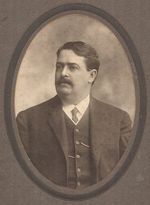Chamber of Commerce - Xalapa
In January 1914 the Cámara Nacional de Comercio de Xalapa decided to issue cheques for 50 centavos and one peso. Less than a week after it had refused the Veracruz chamber's request, the Secretaría de Hacienda approved this issue but refused to exempt it from stamp dutyThe Mexican Herald, 19th Year, No. 6,720, 25 January 1914. Apparently the Chamber first issued 50c notes in March 1914 but within three months they had disappeared. It was suggested that they had all been taken to the surrounding ranches by the peasants who daily brought foodstuffs into the city.
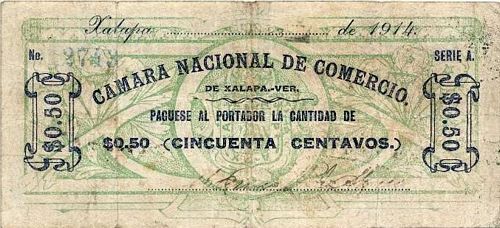
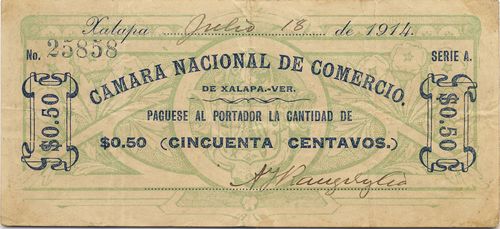 M4110 50c Cámara Nacional de Comercio
M4110 50c Cámara Nacional de Comercio
| Series | date on notes | from | to | total number |
total value |
signed on face by | |
| A | 23 June 1914 | includes number 2743 | |||||
| 30 June 1914 | includes number 7156 | ||||||
| Fuentes | includes number 17994CNBanxico #6398 | ||||||
| 4 July 1914 | [ ] | includes number 19048CNBanxico #12324 | |||||
| 18 July 1914 | A. F. Rangel y Cía. | includes numbers 25858 to 27131CNBanxico #12325 |
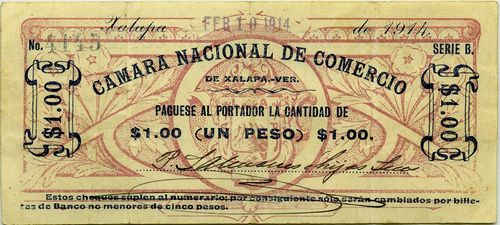
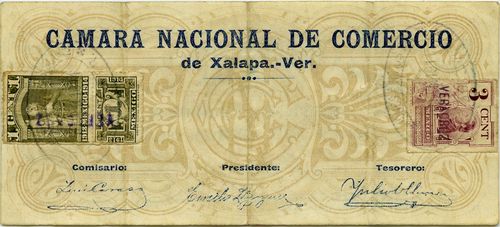 M4111 $1 Cámara Nacional de Comercio
M4111 $1 Cámara Nacional de Comercio
| Series | date on notes | from | to | total number |
total value |
signed on face by | |
| B | includes number 137 | ||||||
| 10 February 1914 | |||||||
| 11 February 1914 | includes number 4145 |
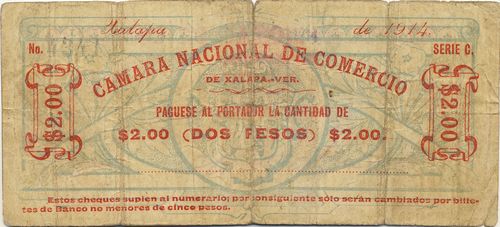
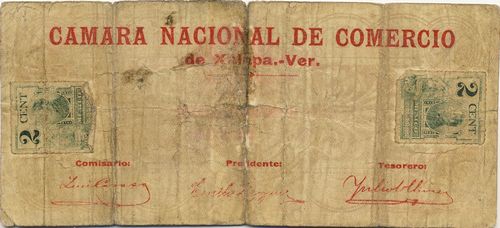 M4112 $2 Cámara Nacional de Comercio
M4112 $2 Cámara Nacional de Comercio
| Series | date on notes | from | to | total number |
total value |
signed on face by | |
| C | includes number 4341 |
The Cámara de Comercio issued a series of three values (50c, $1 and $2). It should be noted that this format was used by several other establishments that issued scrip at around the same time. These other issues date from March to August 1914, are redeemable in quantities of five pesos or multiples thereof, and occasionally refer to the lack of revenue stamps or the amount that has deposited as security for the issue. Such notes includes issues in Coatepec, Teocelo de Díaz, and Misantla. Coatepec and Teocelo de Díaz are just south of Xalapa, whilst Misantla is further north.
These notes have three printed signatures of the Presidente, Tesorero and a Comisario on the reverse and an additional authorising signature on the face. Known signatures are:
|
In April 1907 he became president of the newly-formed Cerveceria “La Estrella” of XalapaDiario Oficial, 19 April 1907 though still with the Cerveceria Toluca y México. In June 1911 there was political unrest in Xalapa over the nomination for provisional governor. A demonstration in favour of Francisco Delgado took place but was quickly countered by another equally fervent demonstration in favour of Léon Aillaud with his supporters bursting into the Palacio del Gobierno and breaking windows. In the evening yet another demonstration took place, also against Delgado, but this time in favour of Emilio Léycegui. The crowd went to his house and made him accompany them in their parade around the city, and apparently forced him to accept their nomination as a candidate. On the night of 21 June the rivalry among the various rebel bands came to a head and many innocent lives were lost. The incident started when federal arrny troops under General García Peña removed several cases of ammunition from the governor's palace. They were opposed by several Maderista groups, although one group, under Esteban Márquez (the first rebels to enter Xalapa), assisted them. In the evening, another group of Maderistas tried to free one of their number from the jail. They opened fire on the police, killing and wounding several. Unfortunately, that evening the park beside the governor's palace was filled with people celebrating Aillaud's nomination at a band concert. They were caught in the crossfire, and between sixty and one hundred were killed. The regular army was able to restore control eventually, and the Márquez faction hurriedly left town. On 22 June, the legislature was still reported as favouring Léycegui, while the revolutionary troops under Aguilar, who was also acting on the orders of the chief of the revolution in Veracruz, Gabriel Gavira, were supporting Aillaud. Aillaud arrived that evening amidst a tumult and El Diario reported that the demonstrations in his favour were the biggest seen in years. From the various newspaper reports, one can only conclude that there were huge groups of supporters for each candidate. Madero then decided to accept the wishes of the stronger and more insistent revolutionary forces and ensure Aillaud's nomination by asking Léycegui to withdraw. He praised the latter to the hilt, explaining that Léycegui was not at all responsible for recent events. Madero maintained that he had not opposed the decision to nominate Aillaud, but that he had had the best reports of Léycegui's ability to calm the state. With Léycegui's obliging withdrawal, Madero's task was made easier. He was grateful to Léycegui for this polítical gift and counselled Gavira to treat Léycegui well because his "situation is quite abnormal." By 23 June order had been restored and the next day Aillaud was appointed provisional governor. Léycegui was president of the Càmara in 1914. He died on 25 July 1939 in Veracruz. |
 |
|
Julio Ollivier was a merchant of French origin who by 1890 had established a clothing store on the corner of calle Enríquez and calle Leandro Valle. In 1898 he was the agent for the Banco Nacional de México. By 1903 he was already well-known in Xalapa, accompanied by his brother Andrés, selling clothes and as owners of "El sombrero de copa", a distinguished shop in the city centre, under the name Ollivier Hnos. Ollivier was tesorero of the Càmara in 1914. |
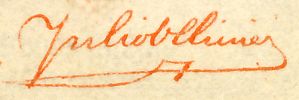 |
|
Luis Caraza Landero was born in Xalapa in 1871. He was the owner of the hacienda Paso San Juan and the La Concepción (or La Concha) sugar cane mill, on the road from Jilotepec to Actopan. Caraza was comisario of the Càmara in 1914. |
 |
|
Rafael Fuentes Vélez was born in Xalapa in 1862. He was manager of the Veracruz branch of the Banco Nacional de MéxicoLa Opinión, Veracruz, Tomo II, Núm. 194, 22 January 1905 and elected mayor (alcalde) in 1906 La Opinión, 19 October 1906. He then went on to be the manager of the Xalapa branch. He was the grandfather of the renowned author, Carlos Fuentes, who records this reminiscence. “My great-grandfather went to Veracruz, and immediately fell in love with the town and lagoon of Catemaco. He went on to establish a prosperous coffee business there, had three daughters (my grandmother, Emilia and my great-aunts Maria and Luisa), integrated his little mulatto daughter Ana (born to another woman) into the family, and forbade his family to speak German. He wanted to be Mexican, to leave the Old World behind. |
 |
 |
|
| In 1911 A. F. Rangel y Cía. ran the “Lucio” drugstore in XalapaRevista de Revistas, Año II, Núm. 100, 24 December 1911. The business was no doubt named after the Xalapeño Rafael Lucio Nájera, a doctor who devoted many years of his life to research leprosy.. |  |
At the same time there was a pair of cheques for 10c, dated 1 July 1914 drawn on the Banco Mercantil de Veracruz (Serie A) and the Banco Nacional de México (Serie B).
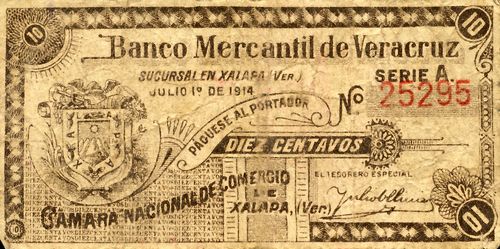
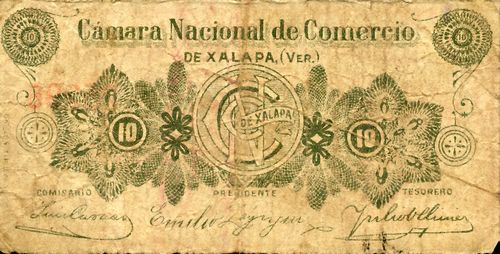 M4114 10c Cámara Nacional de Comercio
M4114 10c Cámara Nacional de Comercio
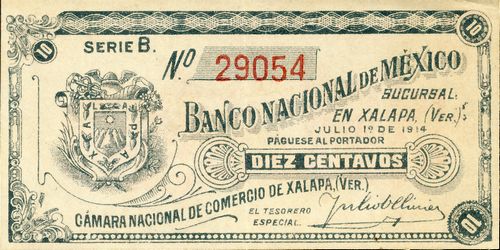
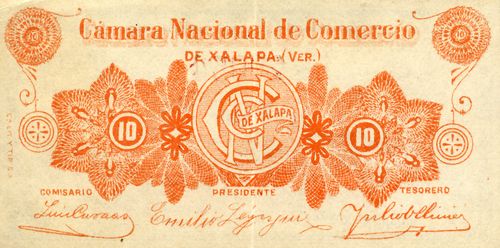 M4116 10c Cámara Nacional de Comercio
M4116 10c Cámara Nacional de Comercio
| Series | from | to | total number |
total value |
||
| 10c | A | 1 | 50000 | 50,000 | $5,000 | includes numbers 18586CNBanxico #7183 to 40803CNBanxico #12327 |
| B | 1 | 50000 | 50,000 | $5,000 | includes numbers 13451CNBanxico #12328 to 42563CNBanxico #6396 | |
| 100,000 | $10,000 |
These also had the signatures of Luis Caraza as Comisario, Emilio Léycegui as Presidente and Julio Ollivier as Tesorero (and Tesorero Especial).
On 11 August 1914 The Mexican Herald reported that "the Jalapa chamber of commerce has requested authority of the department of hacienda to issue vales for five and ten cents to the amount of ten thousand pesos, in order to relieve the difficulty experienced by the commercial establishments in providing change in business transactions of small amounts"The Mexican Herald, 11 August 1914.
Between mid-1914 and 1917 the Junta de Administración Civil in Xalapa undertook to prevent food shortages by authorizing several measures to collect grains and prevent traders from raising prices. In order to reconcile interests, traders tried to create a Regulatory Fund, whose function would be to moderate the costs of grains and prevent them from being an object of speculation. Despite these good intentions, food shortages and abuse did not disappear, although shortages were not as dramatic as they were in other regions.
In the absence of coinage and to facilitate payment for necessities, the Corporation of Jalapa decided to use stamped banknotes and cartones with a sello[image needed] but this measure did not produce good results due to the fact that no small transactions could be made. So it was determined that Luis Caraza would receive the results of sales and distribute banknotes and cartones among merchants. As this disposition did not have an effect, in May 1915 the Junta de Administración Civil asked the governor for authorisation to issue cheques for one and two centavos, which could be changed, when the situation required it, for cartoncillos or the small coinage that was in circulation. However the governor refusedAHX, Actas de Cabildo, libro 108, pp. 187 – 189, sessions of 28 and 31 May 1915. In June it asked the Secretaría de Hacienda y Crédito Público for a similar authorisation. This was approved and the money to guarantee the issue was deposited in the local branch of the Banco Nacional de México. The Junta delegated this task to the Cámara to Comercio, but the latter decided that it did not have the facilities needed to put it into effectAHX, Actas de Cabildo, libro 109, pp. 11-12, 14-16, sessions of 18, 21 and 25 June 1915.
Withdrawal

